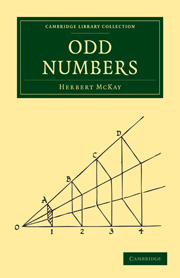Book contents
- Frontmatter
- Contents
- CINDERELLA IN GLASS SLIPPERS
- Millions & Billions & Trillions
- Great Powers & Little Powers
- How we got Logarithms
- Proportion
- Comparisons
- Proportion in Triangles
- Weights & Measures
- The Delusive Average
- Approximations
- Multiplication & Division
- Tables
- Units
- Oddities of Numbers
- The Construction & Solution of Problems
- Scales of Notation
- Frontmatter
- Contents
- CINDERELLA IN GLASS SLIPPERS
- Millions & Billions & Trillions
- Great Powers & Little Powers
- How we got Logarithms
- Proportion
- Comparisons
- Proportion in Triangles
- Weights & Measures
- The Delusive Average
- Approximations
- Multiplication & Division
- Tables
- Units
- Oddities of Numbers
- The Construction & Solution of Problems
- Scales of Notation
Summary
The idea of proportion is as fundamental to arithmetic as are the ideas of continuity and universality. The idea of proportion is so simple, and we assume it so readily, that it is not easy to define what it is.
We say that two quantities are in proportion when one is always the same number of times the other. If one kind of quantity is always twice the other, or always 3 times the other, or always 5¼ times the other, and so on.
We are given the cost of 1 article and asked to find the price of 9 articles. We assume that the total cost is proportional to the number of articles—9 articles cost 9 times as much as 1 article. If that were not so we could not even begin to find an answer. If there were, for example, a reduction for quantities we should want to know more about the sum.
“6d. each, 5s. 6d. per dozen, £2. 2s. per 100,” says a catalogue of plants, and it adds “not less than 6 at the dozen rate; not less than 50 at the 100 rate.” There are evidently three different proportions: for 1 to 5 plants, for 6 to 49 plants, and for 50 to 100 plants. Whatever calculations we make we assume one or other of these proportions. Thus 4 dozen plants at the dozen rate cost 22s., and we realize that it would be better to have 50 plants at the 100 rate for 21s. But, according to the stated terms, we must have one proportion or another.
- Type
- Chapter
- Information
- Odd Numbers , pp. 37 - 60Publisher: Cambridge University PressPrint publication year: 2009First published in: 1940

